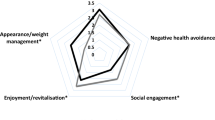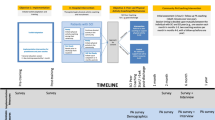Abstract
Study design:
Quasi-experimental translational study with pre- and post-measures.
Objectives:
To determine the effects of the Spinal Cord Injury and Physical Activity in the Community (SCIPA Com) intervention on leisure-time physical activity (LTPA) and associated outcomes among participants with spinal cord injury (SCI).
Setting:
Young Men’s Christian Associations and community fitness centers, Australia and New Zealand.
Methods:
SCIPA Com consisted of three stages: (i) training exercise professionals via the Train the Trainers Spinal Cord Injury course; (ii) implementation of supervised physical activity programs twice a week for 30 to 60 min for 8 to 12 weeks; and (iii) follow-up assessments on health outcomes over 9 months. Participants with SCI were classified as active or inactive by baseline LTPA levels and linear mixed methods compared LTPA between groups over time.
Results:
Sixty-four community-dwelling participants with SCI completed customized physical activity programs. Compared with baseline, there were significant improvements in LTPA (26 min per day, 95% confidence interval (CI): 16.6–35.4; P<0.001), functional goals (2, 95% CI: 1.72–2.37; P<0.001), self-esteem (1.5, 95% CI: 0.72–2.27; P<0.001) and overall quality of life (P<0.05). Over time, LTPA participation was greater among the active compared with the inactive group, although LTPA levels among the inactive improved compared with baseline.
Conclusions:
Significant improvements in LTPA participation and health outcomes were observed, especially among inactive individuals with SCI. SCIPA Com is an ecologically valid intervention based on training and support provided to community exercise professionals who, although new to adapted training, delivered effective physical activity programs for those at risk of inactivity.
Sponsorship:
Transport Accident Commission (Project Number DP172) and the International Postgraduate Research Scholarship (IPRS), Curtin University.
Similar content being viewed by others
Log in or create a free account to read this content
Gain free access to this article, as well as selected content from this journal and more on nature.com
or
References
Hicks AL, Martin Ginis KA, Pelletier CA, Ditor DS, Foulon B, Wolfe DL . The effects of exercise training on physical capacity, strength, body composition and functional performance among adults with spinal cord injury: a systematic review. Spinal Cord 2011; 49: 1103–1127.
van Leeuwen CMC, Kraaijeveld S, Lindeman E, Post MWM . Associations between psychological factors and quality of life ratings in persons with spinal cord injury: a systematic review. Spinal Cord 2012; 50: 174–187.
Rimmer JH, Henley KY . Building the crossroad between inpatient/outpatient rehabilitation and lifelong community-based fitness for people with neurologic disability. JNPT 2013; 37: 72–77.
Anneken V, Hanssen-Doose A, Hirschfeld S, Scheuer T, Thietje R . Influence of physical exercise on quality of life in individuals with spinal cord injury. Spinal Cord 2010; 48: 393–399.
Gainforth HL, Latimer-Cheung AE, Athanasopoulos P, Martin Ginis KA . Examining the feasibility and affectiveness of a community-based organization implementing an event-based knowledge mobilization initiative to promote physical activity guidelines for people with spinal cord injury among support personnel. Health Promot Pract 2014; 16: 55–62.
Park N, Peterson C . Character strengths: research and practice. J Coll Character 2009; 10: 1–10.
Elley CR, Dean S, Kerse N . Physical activity promotion in general practice: patient attitudes. Aust Fam Physician 2007; 36: 1061–1064.
Froehlich-Grobe K, Lee J, Aaronson L, Nary DE, Washburn RA, Little TD . Exercise for everyone: a randomized controlled trial of project workout on wheels in promoting exercise among wheelchair users. Arch Phys Med Rehabil 2014; 95: 20–28.
Wise H, Jackson Thomas K, Nietert P, Brown D, Sword D, Diehl N . Home physical activity programs for the promotion of health and wellness in individuals with spinal cord injury. Top Spinal Cord Inj Rehabil 2009; 14: 122–132.
Martin Ginis KA, Arbour-Nicitopoulos KP, Latimer AE, Buchholz AC, Bray SR, Craven BC et al. Leisure time physical activity in a population-based sample of people with spinal cord injury part II: activity types, intensities, and durations. Arch Phys Med Rehabil 2010; 91: 729–733.
Roberton T, Bucks RS, Skinner TC, Allison GT, Dunlop SA . Barriers to physical activity in individuals with spinal cord injury: a western Australian study. Rehabili Counsell 2011; 17: 74–88.
Kahn EB, Ramsey LT, Brownson RC, Heath GW, Howze EH, Powell KE et al. The effectiveness of interventions to increase physical activity: a systematic review. Am J Prev Med 2002; 22: 73–107.
Kirshblum SC, Burns SP, Biering-Sorensen F, Donovan W, Graves DE, Jha A et al. International standards for neurological classification of spinal cord injury (revised 2011). J Spinal Cord Med 2011; 34: 535–546.
Latimer AE, Martin Ginis KA, Craven BC, Hicks AL . The physical activity recall assessment for people with spinal cord injury: validity. Med Sci Sports Exerc 2006; 38: 208–216.
Stratford P, Gill C, Westaway M, Binkley J . Assessing disability and change on individual patients: a report of a Patient Specific Measure. Physiother Can 1995; 47: 258–263.
Robins RW, Hendin HM, Trzesniewski KH . Measuring global self-esteem: construct validation of a single-item measure and the Rosenberg self-esteem scale. Pers Soc Psychol Bull 2001; 27: 151–161.
World Health Organization. Development of the World Health Organization WHOQOL-BREF quality of Life assessment. Psychol Med 1998; 28: 551–558.
Haskell WL, Lee IM, Pate RR, Powell KE, Blair SN, Franklin BA et al. Physical activity and public health: updated recommendation for adults from the American College of Sports Medicine and the American Heart Association. Med Sci Sports Exerc 2007; 39: 1423–1434.
Martin Ginis KA, Hicks AL, Latimer AE, Warburton DE, Bourne C, Ditor DS et al. The development of evidence-informed physical activity guidelines for adults with spinal cord injury. Spinal Cord 2011; 49: 1088–1096.
Cripps RA . Spinal Cord Injury Australia 2006–07. Injury research and statistics series number 48. Cat. no. INJCAT 119. Adelaide: AIHW. 2008.
Sevick MA, Dunn AL, Morrow MS, Marcus BH, Chen GJ, Blair SN . Cost-effectiveness of lifestyle and structured exercise interventions in sedentary adults: results of project ACTIVE. Am J Prev Med 2000; 19: 1–8.
Rauch A, Fekete C, Cieza A, Geyh S, Meyer T . Participation in physical activity in persons with spinal cord injury: a comprehensive perspective and insights into gender differences. Disabil Health J 2013; 6: 165–176.
Griffiths HC, Clinpsy D, Kennedy P . Continuing with life as normal: positive psychological outcomes following spinal cord injury. Top Spinal Cord Inj Rehabil 2012; 18: 241–252.
Acknowledgements
This study was largely funded by the Transport Accident Commission of the State of Victoria and Curtin University, Australia. We received their unconditional support, and they had no influence on the analysis of results. BIRdeO received support through the International Postgraduate Research Scholarship provided by Curtin University. We thank and acknowledge the assistance received from members of the SCIPA group, participants in this study, the YMCA, participating council fitness centers and SCI organizations.
Author information
Authors and Affiliations
Corresponding author
Ethics declarations
Competing interests
The authors declare no conflict of interest.
Additional information
Supplementary Information accompanies this paper on the Spinal Cord website
Supplementary information
Rights and permissions
About this article
Cite this article
de Oliveira, B., Howie, E., Dunlop, S. et al. SCIPA Com: outcomes from the spinal cord injury and physical activity in the community intervention. Spinal Cord 54, 855–860 (2016). https://doi.org/10.1038/sc.2015.235
Received:
Revised:
Accepted:
Published:
Issue date:
DOI: https://doi.org/10.1038/sc.2015.235



